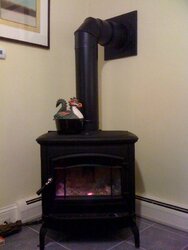Greetings.
I have spent a lot of time reading the forums. So much great info. I just had a Hearthstone Shelburne installed. Yay, today I am running it hard. After reading the forums I have decided I want to get 2 thermometers.. one to put on top of the stove and the other for the double walled flue/pipe. As for the top of the stove, has anyone played with what would be the best location to place it? Right now I have it centered and near the very front. Also, 2nd question, in order to keep creosote building up in the pipe, what would be a good temperate for this purpose? and how long? with the thermo saying 400 (on stove) is this sufficient? also, I may be opening a can of worms here but is one thermo more favorable? such as the Condar?
Thanks again for your wealth of knowledge.
I have spent a lot of time reading the forums. So much great info. I just had a Hearthstone Shelburne installed. Yay, today I am running it hard. After reading the forums I have decided I want to get 2 thermometers.. one to put on top of the stove and the other for the double walled flue/pipe. As for the top of the stove, has anyone played with what would be the best location to place it? Right now I have it centered and near the very front. Also, 2nd question, in order to keep creosote building up in the pipe, what would be a good temperate for this purpose? and how long? with the thermo saying 400 (on stove) is this sufficient? also, I may be opening a can of worms here but is one thermo more favorable? such as the Condar?
Thanks again for your wealth of knowledge.




 The thought of that scares the bejeezes out of me. I would most likely have full lift off with the Mansfield mission to Mars.
The thought of that scares the bejeezes out of me. I would most likely have full lift off with the Mansfield mission to Mars.